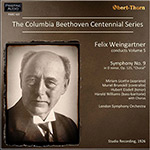
This album is included in the following sets:
This set contains the following albums:
- Producer's Note
- Full Track Listing
- Cover Art
The Columbia Beethoven Centennial Symphony Series, Volume 5
The final instalment in this groundbreaking Symphonic series, Weingartner's brilliant 1926 Ninth, in new Mark Obert-Thorn transfers
This volume is the last of five which have reissued, for the first time in one series, the complete symphony cycle which English Columbia commissioned to commemorate the centennial of Beethoven’s death in 1927. The first four symphonies were assigned to British conductors (Henschel, Beecham, Wood and the Northern Irish Harty) while the remainder were given to Weingartner, already generally acknowledged as a Beethoven specialist.
This final symphony of Beethoven’s was actually the first in the series to be recorded. In fact, the Centennial Symphony Series had not yet been envisioned when it was taken down, and it became a part of it later by default. Columbia had only been making electrical recordings for five months when the ambitious project of recording the Beethoven Ninth was undertaken. By that time, Weingartner had already made acoustic recordings of the Fifth, Seventh and Eighth Symphonies, and had begun an acoustic Sixth that was abandoned when the microphone came in. It was natural that Columbia would turn to him for the electrical recording première of the Ninth.
Weingartner’s reading is, overall, faster than his 1935 remake with the Vienna Philharmonic, although most of the difference is in the final movement, which is swifter by nearly a minute and a half here, and admittedly sounds rushed in places. Part of this may have been due to Columbia’s enforcement of a four-minute limit for twelve-inch sides at this early stage of electrical recording. Like a couple other early recordings of the symphony – Albert Coates’ version from seven months later with much the same orchestral forces (Pristine PASC 296) and Stokowski’s 1934 Philadelphia version – the “Ode to Joy” was sung in English.
The sources for the present transfer were American Columbia “Viva-Tonal” and large label, post-“Royal Blue” shellac pressings. While these are usually the quietest versions available, a higher-than-average amount of surface noise will be noticeable due to the early date of the recording. The downward pitch drift on each side the originals has been corrected through the application of Celemony Capstan, allowing the performance to be heard with rock-solid pitch for the first time since the original recording sessions. I have added a small amount of digital reverberation to bring some warmth to the rather dry studio which Columbia had previously used for acoustic recordings.
Mark Obert-Thorn
-
BEETHOVEN Symphony No. 9 in D minor, Op. 125, "Choral"
Recorded 16–17 March 1926 in the Columbia Studios, Petty France, London
Matrix nos.: WAX 1350-2, 1351-2, 1352-2, 1353-2, 1354-2, 1355-3, 1356-2, 1357-1, 1358-2, 1359-2, 1360-2, 1361-1, 1362-2, 1363-2, 1364-2 & 1365-2
First issued on Columbia L 1775 through 1782
Miriam Licette (soprano)
Muriel Brunskill (contralto)
Hubert Eisdell (tenor)
Harold Williams (bass-baritone)
Chorus and London Symphony Orchestra
Felix Weingartner conductor
Fanfare Reviews
When he was a young man he was introduced to an elderly women who had sung in the chorus at the 1824 Vienna premiere, which was conducted by Beethoven...
This concludes Pristine’s CD issue of the first complete cycle of the Beethoven symphonies to be recorded electrically. The series coincided with the centennial of Beethoven’s 1827 death. Actually, the Ninth was the first to be recorded and replaced an acoustic recording of the piece by Weingartner that was abandoned when electrical recording arrived. According to Mark Obert-Thorn, who did the fine transfer and added just a touch of resonance to enliven the original’s dry sound, the centennial series was conceived after Weingartner’s recording was made and it became a part of the cycle by default. At the time, Weingartner, who went on to record Beethoven’s four previous symphonies as part of the cycle, was regarded as something of a Beethoven expert, though he was erratic about observing cuts, reorchestrated if he thought it necessary, and pretty much ignored the composer’s metronome markings. This is an observation, not a criticism. What gives his two recordings of the Ninth a certain cachet, at least for me, is that, when he was a young man he was introduced to an elderly women who had sung in the chorus at the 1824 Vienna premiere, which was conducted by Beethoven himself. Imagine how thrilling that must have been—two degrees of separation from Beethoven!
He recorded the symphony a second time in 1935 with the Vienna Philharmonic, and it was those 78s that I learned the piece on. The performances are quite similar with two exceptions: The 1927 one, like two other early Ninths (Coates and Stokowski) is sung in English, and he takes the finale faster on the earlier recording. The faster tempo bothered me not a bit; in fact, I thought it exhilarating and, while the English text, often incomprehensible, is no asset, the soloists are quite good—Harold Williams still sounds like himself 20 years later. It seems to me that, perhaps due to the use of a slightly smaller string section and/or “tighter” acoustics, more inner detail is heard on the 1927 recording than on the later one. These two Weingartners, needless to say, have been surpassed sonically through the years, but in their straightforward, no-nonsense directness, they still hold up very nicely as performances, per se. and I’m delighted to have them both.
James Miller
This article originally appeared in Issue 38:5 (May/June 2015) of Fanfare Magazine.

